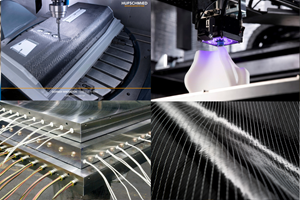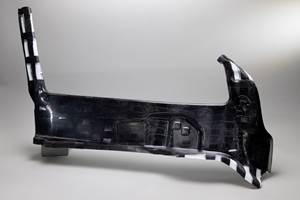Thermoset prepregs meet lightning strike protection specifications
CAMX 2024: A.P.C.M. highlights how its range of epoxy prepreg offerings undergo and surpass lighting strike testing.
Share
Adhesive Prepregs for Composite Manufacturers (A.P.C.M., Plainsfield, Conn., U.S.) has been developing thermoset epoxy prepregs for the manufacturers, designers and hobbyists of composite parts since 1992. A.P.C.M. highlights how its standard epoxy prepreg systems and substrates are available for lightning strike testing review. To achieve this, the company develops the panels and sends them for testing by the Elements Testing Group (Pittsfield Mass., U.S.).
A.P.C.M. breaks down this process. To create the test panels, the company lays up 22 plies of material, the top ply being the lightning strike carbon fiber prepreg. Complete panels are 27" × 27" and 0.20-0.22 thousands thick. Debulking, curing and paint parameters are per Boeing specifications.
Panels testing shows two panels — differentiated by the thickness and the weight of the needle punched copper foil used to make the lightning strike prepreg — prior to and after strike tests. Testing is called zone 1 and zone 2, which equates to the power of the electricity used to strike the panel. One panel had a 0.029 Ib/2ft of copper and the other 0.040 Ib/2ft of copper. Each panel experienced surface damage but maintained their structural strength and protected against lightning strikes. which can result in the shorting out any of an aircraft’s electrical components.
At its booth, A.P.C.M. is showing a high-speed video of the test being performed, as well as all of its other standard thermoset epoxy prepreg products, from 180-375°F curing systems, including specialty woven and standard woven substrates from glass to carbon fiber to Kevlar. This includes hybrid carbon fiber/colored glass, carbon fiber/Kevlar, spread tow carbon, flax and hemp. Cured and uncured samples, as well as substrates are available for attendees to view.
Related Content
-
CAMX 2023 exhibit preview compilation, Part 2
Part 2 continues to showcase the materials, services, machinery, live demonstrations and other innovations presented by CAMX 2023 exhibitors.
-
VIDEO: Flexible molding and machining for composites
Addcomp and bespline are sister companies that offer innovative solutions for composites. This video from CAMX 2024 offers an overview of Addcomp’s AFP solutions.
-
Highly tunable, woven lattice reinforcements target automotive structures
CAMX 2023: Startup Weav3D will be demonstrating its two collaborative automotive demonstrator parts and present two conference papers.
Related Content
CAMX 2023 exhibit preview compilation, Part 2
Part 2 continues to showcase the materials, services, machinery, live demonstrations and other innovations presented by CAMX 2023 exhibitors.
Read MoreVIDEO: Flexible molding and machining for composites
Addcomp and bespline are sister companies that offer innovative solutions for composites. This video from CAMX 2024 offers an overview of Addcomp’s AFP solutions.
Read MoreHighly tunable, woven lattice reinforcements target automotive structures
CAMX 2023: Startup Weav3D will be demonstrating its two collaborative automotive demonstrator parts and present two conference papers.
Read MoreCAMX 2023 exhibit preview compilation, Part 1
Prepare for CAMX 2023 in Atlanta with this list of 60+ exhibitor previews received by CW, highlighting key technologies, services and trends available to attendees.
Read MoreRead Next
Surfacing Film Incorporates LSP Into One Ready-to-Use Film
Lightning can create serious risks to the structural integrity of the aircraft and to the safety of its passengers. That’s where lightning strike protection comes in.
Read MoreAssembling the Multifunctional Fuselage Demonstrator: The final welds
Building the all-thermoplastic composite fuselage demonstrator comes to an end with continuous ultrasonic welding of the RH longitudinal fuselage joint and resistance welding for coupling of the fuselage frames across the upper and lower halves.
Read MoreAll-recycled, needle-punched nonwoven CFRP slashes carbon footprint of Formula 2 seat
Dallara and Tenowo collaborate to produce a race-ready Formula 2 seat using recycled carbon fiber, reducing CO2 emissions by 97.5% compared to virgin materials.
Read More







